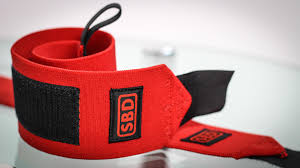The Ultimate Guide to Wrist Wraps

Strong 8k brings an ultra-HD IPTV experience to your living room and your pocket.
Wrist wraps are one of the most popular and effective accessories in strength training and sports performance. Whether you're lifting heavy weights, practicing powerlifting, or participating in other high-intensity activities, wrist wraps provide much-needed support to the wrists, preventing injuries and boosting performance. This article explores the benefits of wrist wraps, their uses, and how to choose the best pair for your workout routine.
What Are Wrist Wraps?
Wrist wraps are supportive bands, often made of elastic materials such as cotton, polyester, or a blend of both, designed to be wrapped around the wrist area to stabilize and support the joints during physical activity. They typically feature adjustable Velcro or hook-and-loop closures to ensure a snug and secure fit, and come in various lengths, thicknesses, and designs.
Why Are Wrist Wraps Important?
The wrist is a crucial joint when it comes to weightlifting and other athletic activities. During exercises like bench presses, overhead presses, deadlifts, or squats, the wrists are subjected to heavy stress. Over time, this can lead to strains, sprains, or even more serious injuries if not properly supported. Wrist wraps act as an external support system that helps stabilize the wrist joint, distributing the load more evenly and reducing the risk of injury.
Key Benefits of Wrist Wraps
Enhanced Wrist Support
Wrist wraps provide immediate support to the wrist joint, which helps reduce excessive movement that could lead to injury. This is particularly helpful during heavy lifting when the wrist is often under tension.
Injury Prevention
By limiting hyperextension or hyperflexion of the wrist, wrist wraps can prevent both acute and chronic injuries, such as strains, sprains, and tendonitis, especially when lifting heavy weights or performing repetitive movements.
Improved Performance
With better wrist stability, athletes can focus on lifting heavier weights or performing exercises with more control. The added support may allow you to push beyond your previous limits, especially in pressing movements where wrist fatigue can compromise your form.
Better Wrist Alignment
Wrist wraps help maintain proper wrist alignment during movements, which is vital to avoid putting unnecessary stress on tendons and ligaments. This can help prevent long-term damage or wear on the joint.
Increased Confidence
Knowing that your wrists are protected gives athletes the confidence to perform at their best, without the fear of injury holding them back.
Who Should Use Wrist Wraps?
Wrist wraps are ideal for athletes and weightlifters who perform high-intensity exercises that place significant stress on the wrist joint. This includes:
Powerlifters: In powerlifting, wrist wraps are used to provide support during the squat, bench press, and deadlift, especially when lifting maximum loads.
Bodybuilders: For exercises that target the upper body, such as overhead presses, bench presses, and curls, wrist wraps help support the wrist through higher-volume training.
CrossFit Athletes: CrossFit workouts often include high-repetition lifts, Olympic lifts, and bodyweight movements that can cause wrist strain. Wrist wraps provide the stability needed during these workouts.
Olympic Weightlifters: Due to the explosive movements in Olympic lifting (such as the snatch or clean and jerk), wrist wraps are often used to maintain stability and prevent wrist injuries.
Anyone with a History of Wrist Pain: Athletes recovering from a wrist injury or anyone prone to wrist pain during exercise can benefit from wrist wraps as part of their rehabilitation.
How to Choose the Right Wrist Wraps
When selecting wrist wraps, there are several factors to consider to ensure you get the right pair for your needs:
Material
Wrist wraps come in various materials, including cotton, elastic, and blends. Cotton is soft and comfortable, while elastic wraps provide more support and compression. Choose the material that suits your activity level and comfort preference.
Length
Wrist wraps typically come in two standard lengths: 12-inch and 18-inch wraps. Shorter wraps are good for moderate support, while longer wraps offer more extensive coverage and support, making them ideal for heavy lifting.
Elasticity
The elasticity of the wrap determines how much tension it provides to the wrist. More elastic wraps offer more support but can be less flexible. If you're looking for rigid support, opt for a wrap with higher elasticity. If you want a more flexible option, choose a less elastic wrap.
Closure Mechanism
Most wrist wraps have a hook-and-loop (Velcro) closure, which allows for easy adjustment. However, some athletes prefer wraps with a buckle or other fastening systems. The closure should be secure and adjustable to ensure a snug fit during exercise.
Thickness
The thickness of the wrist wrap will affect the level of compression and support it provides. Thicker wraps offer more stability but can be bulkier, while thinner wraps provide more flexibility but may not offer as much support.
Comfort and Fit
Comfort is key when wearing wrist wraps, especially during long training sessions. Make sure the wraps fit well, are adjustable, and don’t cause discomfort during movement. Look for wrist wraps that feature a padded or soft lining for extra comfort.
How to Use Wrist Wraps
Wrap Around the Wrist: Start by placing the wrap around the base of your wrist and begin wrapping it around in a circular fashion.
Adjust for Tightness: Adjust the tension of the wrap depending on the level of support you need. A snug fit will provide optimal support, but it shouldn't be so tight that it restricts blood flow.
Secure the Closure: Once you've wrapped the wrist, secure the Velcro or closure mechanism tightly to keep the wrap in place. Make sure it’s not too loose or too tight.
Test for Comfort: Before beginning your lift or exercise, test the wraps for comfort. Your wrist should feel supported but still able to move naturally within a safe range of motion.
Conclusion
Wrist wraps are an essential tool for many athletes and weightlifters. They provide enhanced support, help prevent injuries, improve performance, and give you the confidence to push your limits. When choosing wrist wraps, consider the material, length, elasticity, and closure system that best suits your training style and needs. Whether you're lifting heavy weights, participating in CrossFit, or recovering from an injury, wrist wraps can make a significant difference in your overall performance and wrist health.
By incorporating wrist wraps into your training routine, you’ll not only protect your wrists but also enhance your ability to lift, push, and perform at your best.
Note: IndiBlogHub features both user-submitted and editorial content. We do not verify third-party contributions. Read our Disclaimer and Privacy Policyfor details.


